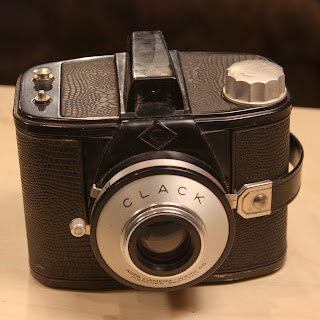The Agfa Clack was manufactured in Germany from the mid-1950s to mid-1960s, and apparently the later iterations featured a plastic body. On first look, the camera has a vaguely oval shape, due to the curved back to reduce aberration in the images. The features are pretty simple:
Meniscus lens with two apertures - ca. f/13 and f/10
Shutter about 1/30 plus B
Built-in yellow filter on some models
Close-up lens for 1-3m distance
otherwise, focus is at 3m -infinity
tripod socket centered on bottom
simple viewfinder
red window with movable cover for frame number
cable-release socket
Back in the days of big box cameras, it was routine to get contact prints back from your local drugstore when you dropped off your film, as 2.25 x 3.25" (6x9 cm) prints are decent-sized, and the best shots could be sent out for reprints at a larger size. If you understood the limitations of your camera and exposed properly, the Clack and many other box camera were adequate snap shot cameras. Today, such cameras are put into the "Toy Camera" category, but they really aren't toy cameras. They were designed and produced at a higher price point than what would later become cheap plastic cameras with light leaks and lens aberrations.
My goal with this particular Agfa Clack is to see how well it would work as a camera to take on local photo trips to see how it renders a scene. The large negative is an obvious plus, as is the ergonomics of the camera. It handles much better than say, a Kodak Brownie 120 box camera. For my use, I knew that the tripod socket, B mode, and cable release connector were just the things I needed to use the camera for landscapes in the NC mountains.
My first roll was expired Kodak TMax 400, which I shot walking around Marshall, NC on May 1. Hand holding the camera works pretty well, and the negatives (developed in D-96) looked pretty good. The vertical shots were a bit blurred due to camera shake, but the landscape orientation was just fine.
That encouraged me to take the Clack to Rocky Fork State Park in Tennessee 2 weeks later. To photograph the creek, I rated the expired Tmax 400 at ISO 100, and the f/13 setting in the shady conditions gave me an exposure time of 1/2 sec or so. That meant using the tripod and a cable release to shoot in Bulb mode. I estimated the exposure time and hoped for the best. I developed the film in D-96, and am thrilled with the results. From this, I know I can also put even slower films in it, such as Ilford Pan-F and Rollei Retro 80s. The trick is to figure out the exposure with a light meter, and try and approximate it in B mode. If it is sunny, I could tape a piece of ND gel over the lens for the longer exposure time.
 |
| Marshall, NC |
 |
| Marshall, NC, Madison County seat |
 |
| Rocky Fork State Park, TN. |
 |
| Rocky Fork State Park, TN. |
 |
| Rocky Fork State Park, TN. |
If anything, this exercise shows very well that one can overcome a camera's limitations with a little bit of care and planning. I love the larger negative and look forward to shooting more riparian scenes with the Agfa Clack. I have an Agfa Isola which makes 6x6 negatives and has features similar to the Clack. I'll take it along, and see how it does in the same situations.
Maybe you have a 120 box camera in your collection. Don't be afraid to shoot with it! Use ISO 100 film, as the cameras were made when Verichrome Pan (ISO 125) was THE film for box cameras. Or, if you use a ISO 400 film, shoot on overcast conditions.






1 comment:
Awesome post. I LOVE my Clack. I got it about 5 years ago and still use it regularly.
Post a Comment